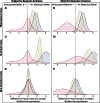Expert prior elicitation and Bayesian analysis of the Mycotic Ulcer Treatment Trial I
- PMID: 23702779
- PMCID: PMC3684218
- DOI: 10.1167/iovs.13-11716
Expert prior elicitation and Bayesian analysis of the Mycotic Ulcer Treatment Trial I
Abstract
Purpose: To perform a Bayesian analysis of the Mycotic Ulcer Treatment Trial I (MUTT I) using expert opinion as a prior belief.
Methods: MUTT I was a randomized clinical trial comparing topical natamycin or voriconazole for treating filamentous fungal keratitis. A questionnaire elicited expert opinion on the best treatment of fungal keratitis before MUTT I results were available. A Bayesian analysis was performed using the questionnaire data as a prior belief and the MUTT I primary outcome (3-month visual acuity) by frequentist analysis as a likelihood.
Results: Corneal experts had a 41.1% prior belief that natamycin improved 3-month visual acuity compared with voriconazole. The Bayesian analysis found a 98.4% belief for natamycin treatment compared with voriconazole treatment for filamentous cases as a group (mean improvement 1.1 Snellen lines, 95% credible interval 0.1-2.1). The Bayesian analysis estimated a smaller treatment effect than the MUTT I frequentist analysis result of 1.8-line improvement with natamycin versus voriconazole (95% confidence interval 0.5-3.0, P = 0.006). For Fusarium cases, the posterior demonstrated a 99.7% belief for natamycin treatment, whereas non-Fusarium cases had a 57.3% belief.
Conclusions: The Bayesian analysis suggests that natamycin is superior to voriconazole when filamentous cases are analyzed as a group. Subgroup analysis of Fusarium cases found improvement with natamycin compared with voriconazole, whereas there was almost no difference between treatments for non-Fusarium cases. These results were consistent with, though smaller in effect size than, the MUTT I primary outcome by frequentist analysis. The accordance between analyses further validates the trial results. (ClinicalTrials.gov number, NCT00996736.).
Keywords: Bayesian; clinical trial; corneal ulceration; fungal keratitis; statistics.
Figures


References
-
- Srinivasan M. Fungal keratitis. Curr Opin Ophthalmol. 2004; 15: 321–327 - PubMed
-
- Alfonso EC, Cantu-Dibildox J, Munir WM, et al. Insurgence of Fusarium keratitis associated with contact lens wear. Arch Ophthalmol. 2006; 124: 941–947 - PubMed
-
- Alfonso EC, Miller D, Cantu-Dibildox J, O'Brien TP, Schein OD. Fungal keratitis associated with non-therapeutic soft contact lenses. Am J Ophthalmol. 2006; 142: 154–155 - PubMed
Publication types
MeSH terms
Substances
Associated data
Grants and funding
LinkOut - more resources
Full Text Sources
Other Literature Sources
Medical

